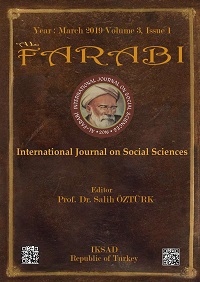KENTSEL DEĞİŞİMİN COĞRAFİ BOYUTLARI: ELAZIĞ ÖRNEĞİ
Anahtar Kelimeler:
Kentsel Değişim, Elazığ, Nüfus, Yerleşme, EkonomiÖzet
Kentsel değişim kavramı, kentsel dönüşüm veya kentsel yenileme gibi kavramlardan daha geniş bir alanı ifade etmektedir. Bu nedenle kentlerdeki değişim genellikle ayrı unsur ve olgular üzerinde değerlendirilmektedir. Çalışma sahası olarak seçilen Elazığ kenti 19.yy’da ortaya çıkmış ve son yıllarda değişimin arttığı bir Doğu Anadolu Kentidir. Çalışmada arazi gözlemleri, uydu görüntüleri, resmi istatistikler ile imar ve hali hazır planları temel veri kaynakları olarak kullanılmıştır. Nüfus açısından şehrin artış eğiliminde olduğu, şehir merkezinde nüfus azalırken, gelişme akslarında arttığı, kentin pozitif bir göç hızına sahip olduğu görülmüştür. Yerleşmede ise kentin farklı dönemlerde farklı büyüme formları gösterdiği, dönemsel olarak yerleşme dokularının benzerlik gösterdiği, yerleşme dokusu üzerinde toplu konut projelerinin ve konutların bulunduğu jeomorfolojik birimin etkili olduğu ve son yıllarda kat sayısında belirgin bir artış yaşandığı tespit edilmiştir. Ulaşım açısından ise trafik yoğunluğunun artmasıyla birlikte cadde ve bulvarların genişletildiği, yeni cadde ve bulvarların oluşturulduğu, kavşaklardaki trafik problemi için alt geçitli veya köprülü çözümlerin giderek arttığı görülmüştür. Arazi kullanımında, resmi kurumların kentin yakın çevresine doğru taşındığı, rekreasyon alanlarının arttığı ve güney çevre yolunun yer seçimindeki etkisini arttırdığı tespit edilmiştir. Ekonomik açıdan ise konut ve arsa değerlerinde artışın yanında, sanayi, ticaret ve turizm sektörlerinde büyüme yaşandığı görülmüştür. Kentlerdeki değişime daha kapsamlı bakabilmek için değişime ait unsurların Elazığ kenti örneğinde tespit edilmesi ve bilhassa 1990’lı yıllardan sonra ne şekilde değişimin yaşandığını açıklamak çalışmanın odağını oluşturmaktadır.




